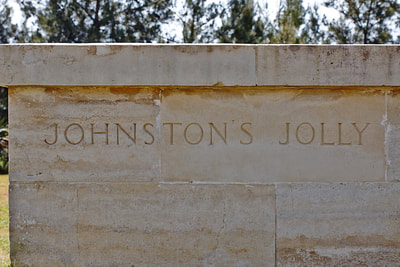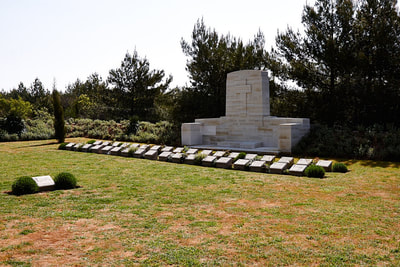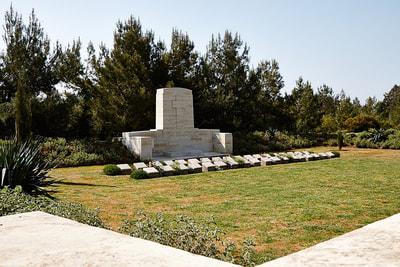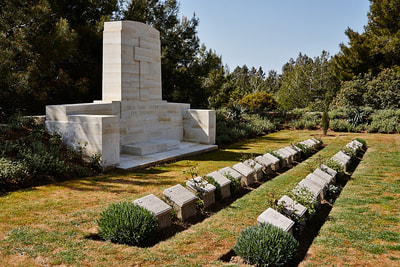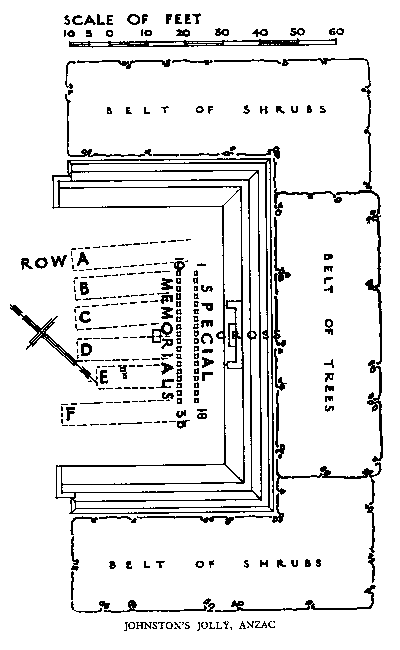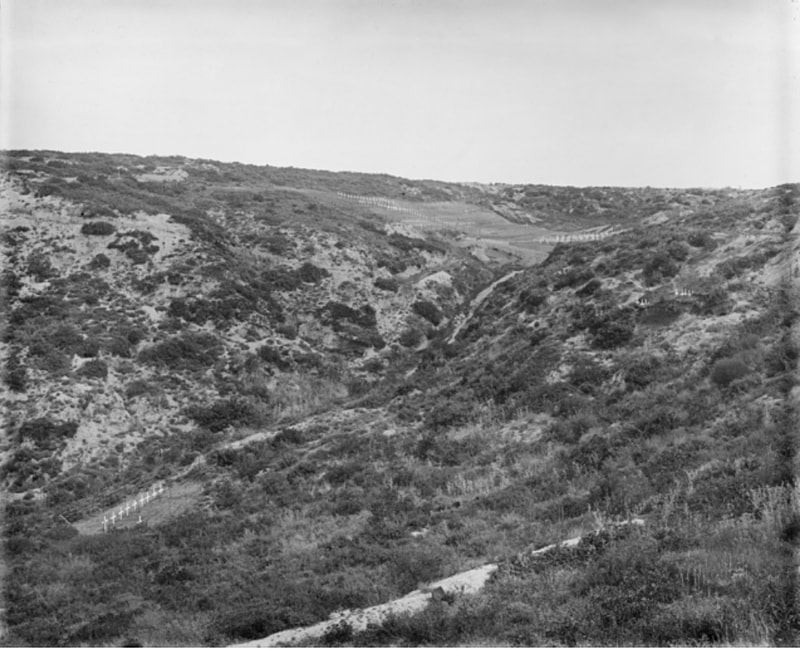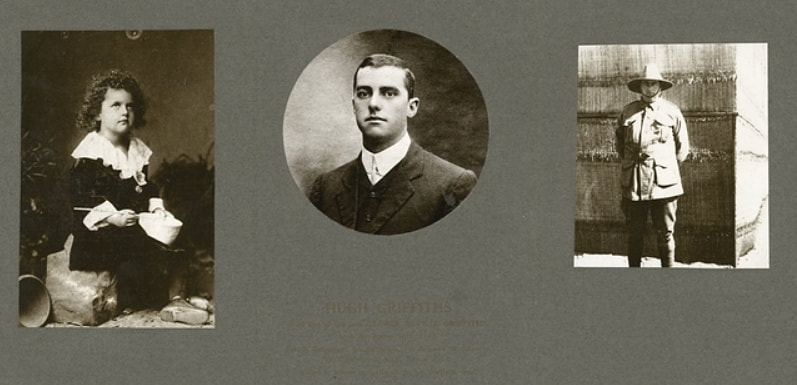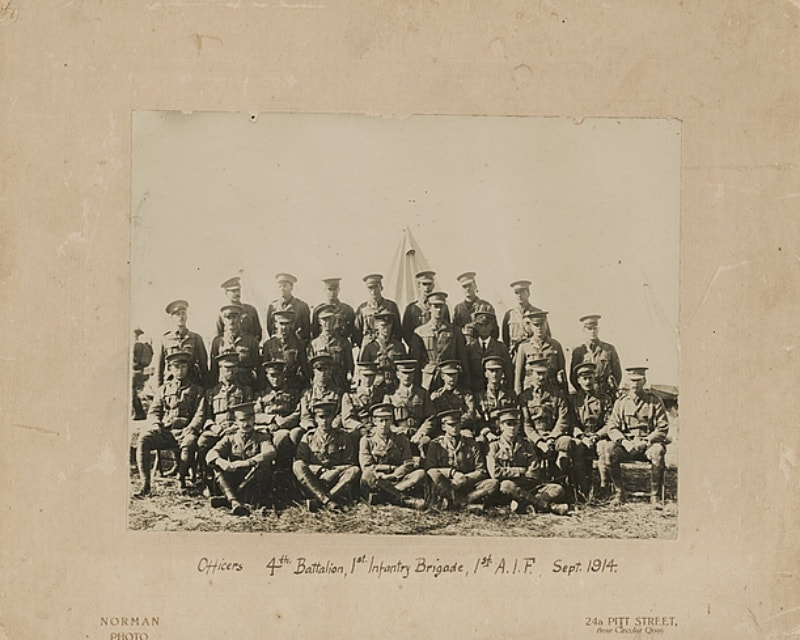JOHNSTON'S JOLLY CEMETERY
Gallipoli
Turkey
Location Information
The Anzac and Suvla cemeteries are first signposted from the left hand junction of the Eceabat - Bigali road. From this junction you should travel into the main Anzac area. 400metres past Lone Pine Cemetery and Memorial you will find Johnston's Jolly. This cemetery stands on the northern part of Plateau 400 in the Anzac part of the peninsular.
Visiting Information
The Cemetery is permanently open and may be visited at any time.
Historical Information
The Gallipoli campaign was mounted by Commonwealth and French forces in an attempt to force Turkey out of the war, to relieve the stalemate of the Western Front in France and Belgium, and to open a supply route to Russia through the Dardanelles and Black Sea.
Allied landings were made on 25-26 April 1915 at Helles, on the southern tip of the peninsula, and on the west coast, in an area which later became known as Anzac. On 6 August, further landings were made at Suvla, just north of Anzac, and the climax of the campaign came in early August when simultaneous assaults were launched on these three fronts.
Johnston's Jolly (called by the Turks Kirmezi Sirt, or 'Red Ridge'), was named from the commander of the 2nd Australian Division Artillery, Brigadier-General G J Johnston, CB, CMG, VD. The position was reached by the 2nd Australian Infantry Brigade on 25 April 1915, but lost the next day and it was never retaken.
The cemetery was made after the Armistice when graves were brought in from the battlefield.
There are now 181 Commonwealth servicemen buried or commemorated in this cemetery. 144 of the burials are unidentified and there are special memorials to 36 Australian casualties believed to be buried among them, almost all of whom were killed in the capture of Lone Pine in August 1915.
Identified Casualties:
Australia 37
Pictures in gallery © Geerhard Joos
The Anzac and Suvla cemeteries are first signposted from the left hand junction of the Eceabat - Bigali road. From this junction you should travel into the main Anzac area. 400metres past Lone Pine Cemetery and Memorial you will find Johnston's Jolly. This cemetery stands on the northern part of Plateau 400 in the Anzac part of the peninsular.
Visiting Information
The Cemetery is permanently open and may be visited at any time.
Historical Information
The Gallipoli campaign was mounted by Commonwealth and French forces in an attempt to force Turkey out of the war, to relieve the stalemate of the Western Front in France and Belgium, and to open a supply route to Russia through the Dardanelles and Black Sea.
Allied landings were made on 25-26 April 1915 at Helles, on the southern tip of the peninsula, and on the west coast, in an area which later became known as Anzac. On 6 August, further landings were made at Suvla, just north of Anzac, and the climax of the campaign came in early August when simultaneous assaults were launched on these three fronts.
Johnston's Jolly (called by the Turks Kirmezi Sirt, or 'Red Ridge'), was named from the commander of the 2nd Australian Division Artillery, Brigadier-General G J Johnston, CB, CMG, VD. The position was reached by the 2nd Australian Infantry Brigade on 25 April 1915, but lost the next day and it was never retaken.
The cemetery was made after the Armistice when graves were brought in from the battlefield.
There are now 181 Commonwealth servicemen buried or commemorated in this cemetery. 144 of the burials are unidentified and there are special memorials to 36 Australian casualties believed to be buried among them, almost all of whom were killed in the capture of Lone Pine in August 1915.
Identified Casualties:
Australia 37
Pictures in gallery © Geerhard Joos
Three portraits which appear in an In Memoriam booklet of 405 Sergeant (Sgt) Hugh Griffiths, A Company, 4th Battalion, of Sydney, NSW. A grazier prior to enlisting on 21 April 1914, Griffiths was killed in action at Lone Pine, Gallipoli on 6 August 1915, aged 29. The portrait on the left depicts Griffiths as a young boy; the portrait in the middle prior to enlisting; the portrait on the right in Egypt in early 1915. Underneath the middle portrait is the following caption in gold lettering: 'Hugh Griffiths / Third son of the late George Neville Griffiths / Born November 18th 1885 / Sgt A Company, 4th battalion, 1st Brigade of Infantry / 1st Contingent, AIF Force 1914 / Killed in action in Gallipoli in his thirtieth year'.
405 Sergeant Hugh Griffiths, 4th Bn. Australian Infantry, A. I. F. died 6th August 1915, aged 29. Special Memorial 24. Son of George Neville Griffiths and Ada Frances Griffiths. Native of Sydney, New South Wales. Inscription "Son of George Neville and Ada Frances Griffiths of Sydney.
405 Sergeant Hugh Griffiths, 4th Bn. Australian Infantry, A. I. F. died 6th August 1915, aged 29. Special Memorial 24. Son of George Neville Griffiths and Ada Frances Griffiths. Native of Sydney, New South Wales. Inscription "Son of George Neville and Ada Frances Griffiths of Sydney.
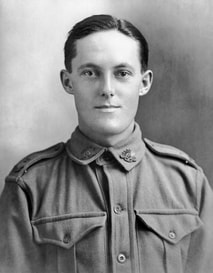
2155 Lance Corporal
John Grieve Limerock
7th Bn. Australian Infantry, A. I. F.
Died between 8th August 1915 and 9th August 1915, aged 20 on Lone Pine, Gallipoli.
Special Memorial 10.
Click on image to enlarge
Inscription "Until the day break and the shadows flee away"
Son of the late John and Elizabeth Limerock. Native of Melbourne, Australia.
John Grieve Limerock
7th Bn. Australian Infantry, A. I. F.
Died between 8th August 1915 and 9th August 1915, aged 20 on Lone Pine, Gallipoli.
Special Memorial 10.
Click on image to enlarge
Inscription "Until the day break and the shadows flee away"
Son of the late John and Elizabeth Limerock. Native of Melbourne, Australia.
Group portrait of officers of the 4th Battalion prior to embarkation.
Identified from left to right, back row:
Second Lieutenant (2nd Lt) John Dawson Christie from Sydney, NSW (later Lieutenant); 2nd Lt Percival Francis Vere Turner from Edgecliffe, NSW (later Lieutenant); 2nd Lt William Reginald Rogers French from Rose Bay, NSW; 2nd Lt Stanley Lyndall Milligan from Chatswood, NSW (later Lieutenant Colonel and awarded Order of St Michael and St George (CMG), Distinguished Service Order (DSO), and Mentioned in Despatches (MID) five times); 2nd Lt Arthur McKellar Giles from Sydney (later Lieutenant and killed in action at Gallipoli on 8 August 1915); 2nd Lt Desmond Trench from Sydney (later Lieutenant); and 2nd Lt Frederick Fanning from Casino, NSW (later Captain, MID twice and died of wounds in France on 1 November 1916).
Third row:
2nd Lt James Bloomfield Osborne from Paddington, NSW (later Captain and MID); 2nd Lt Bertie Vandeleur Stacy from Crossington, NSW (later Lieutenant Colonel and awarded CMG, DSO and Bar, and MID six times); 2nd Lt Edward Acton Lloyd from Rose Bay, NSW (later Major and MID); 2nd Lt James Sinclair Standish Anderson from Glen Innes, NSW (later Major and awarded DSO, Military Cross (MC), and MID three times); Lt Sherard Michael Becher from Strathfield, NSW; 2nd Lt Robert John Allwright Massie from North Sydney (later Lieutenant Colonel and awarded DSO, French Croix de Guerre (C de G) and MID three times); Lt Charles Athleston Chard from Sydney (resigned 3 April 1915); 2nd Lt Richard Thomas Francis Seldon from North Sydney (later Lieutenant and killed in action at Gallipoli on 8 August 1915); and 2nd Lt Arthur Roland Edwards from Sydney (later Major and MID).
Second row:
Major (Maj) David Andrew Storey from Sydney; Lt Hector Joseph Robert Clayton from Sydney (later Major and MID); Lt J T Simpson, possibly Lt Adam James Simpson from Hunter’s Hill (later Major); Lt Allen Humphrey Scott from Wahroonga, NSW (later Lieutenant Colonel, awarded DSO and MID three times and killed in action in Belgium on 1 October 1917); Maj Charles Melville Macnaghten from Sydney (later awarded CMG and MID); Lieutenant Colonel Astley John Onslow Thompson from Menangle, NSW (later MID and killed in action at Gallipoli on 26 April 1915); Captain (Capt) Iven Gifford Mackay from Raymond Terrace (later Brigadier General and awarded CMG, DSO and Bar, French C de G and MID five times); Capt Stewart Milson from Milson’s Point, NSW (later MID and killed in action at Gallipoli on 7 August 1915); Lt Jasper Kenneth Gordon Magee from Sydney (later Major and awarded MC and MID); Capt James Heane from Dubbo (later Brigadier General and awarded Companion of the Order of the Bath (CB), CMG, DSO, Belgian C de G, and MID five times); and Capt Charles Stanley Coltman from Sydney (later awarded MC and MID and died of disease in Egypt on 6 January 1916).
Front row:
Lt William Thomas McDonald from Forest Lodge, NSW (later Captain, MID and killed in action in France on 16 August 1916); 2nd Lt Muir Paul Smith from North Sydney (later Lieutenant, MID and killed in action at Gallipoli on 26 April 1915); Capt Arthur Hamilton Tebbutt from Quirindi, NSW (later Lieutenant Colonel and awarded DSO and MID twice); Lt David Richmond Brown from Katoomba, NSW (later Major and awarded MC and MID); and 2nd Lt Clarence Gordon Milne from Darlinghurst, NSW (later Captain).
Identified from left to right, back row:
Second Lieutenant (2nd Lt) John Dawson Christie from Sydney, NSW (later Lieutenant); 2nd Lt Percival Francis Vere Turner from Edgecliffe, NSW (later Lieutenant); 2nd Lt William Reginald Rogers French from Rose Bay, NSW; 2nd Lt Stanley Lyndall Milligan from Chatswood, NSW (later Lieutenant Colonel and awarded Order of St Michael and St George (CMG), Distinguished Service Order (DSO), and Mentioned in Despatches (MID) five times); 2nd Lt Arthur McKellar Giles from Sydney (later Lieutenant and killed in action at Gallipoli on 8 August 1915); 2nd Lt Desmond Trench from Sydney (later Lieutenant); and 2nd Lt Frederick Fanning from Casino, NSW (later Captain, MID twice and died of wounds in France on 1 November 1916).
Third row:
2nd Lt James Bloomfield Osborne from Paddington, NSW (later Captain and MID); 2nd Lt Bertie Vandeleur Stacy from Crossington, NSW (later Lieutenant Colonel and awarded CMG, DSO and Bar, and MID six times); 2nd Lt Edward Acton Lloyd from Rose Bay, NSW (later Major and MID); 2nd Lt James Sinclair Standish Anderson from Glen Innes, NSW (later Major and awarded DSO, Military Cross (MC), and MID three times); Lt Sherard Michael Becher from Strathfield, NSW; 2nd Lt Robert John Allwright Massie from North Sydney (later Lieutenant Colonel and awarded DSO, French Croix de Guerre (C de G) and MID three times); Lt Charles Athleston Chard from Sydney (resigned 3 April 1915); 2nd Lt Richard Thomas Francis Seldon from North Sydney (later Lieutenant and killed in action at Gallipoli on 8 August 1915); and 2nd Lt Arthur Roland Edwards from Sydney (later Major and MID).
Second row:
Major (Maj) David Andrew Storey from Sydney; Lt Hector Joseph Robert Clayton from Sydney (later Major and MID); Lt J T Simpson, possibly Lt Adam James Simpson from Hunter’s Hill (later Major); Lt Allen Humphrey Scott from Wahroonga, NSW (later Lieutenant Colonel, awarded DSO and MID three times and killed in action in Belgium on 1 October 1917); Maj Charles Melville Macnaghten from Sydney (later awarded CMG and MID); Lieutenant Colonel Astley John Onslow Thompson from Menangle, NSW (later MID and killed in action at Gallipoli on 26 April 1915); Captain (Capt) Iven Gifford Mackay from Raymond Terrace (later Brigadier General and awarded CMG, DSO and Bar, French C de G and MID five times); Capt Stewart Milson from Milson’s Point, NSW (later MID and killed in action at Gallipoli on 7 August 1915); Lt Jasper Kenneth Gordon Magee from Sydney (later Major and awarded MC and MID); Capt James Heane from Dubbo (later Brigadier General and awarded Companion of the Order of the Bath (CB), CMG, DSO, Belgian C de G, and MID five times); and Capt Charles Stanley Coltman from Sydney (later awarded MC and MID and died of disease in Egypt on 6 January 1916).
Front row:
Lt William Thomas McDonald from Forest Lodge, NSW (later Captain, MID and killed in action in France on 16 August 1916); 2nd Lt Muir Paul Smith from North Sydney (later Lieutenant, MID and killed in action at Gallipoli on 26 April 1915); Capt Arthur Hamilton Tebbutt from Quirindi, NSW (later Lieutenant Colonel and awarded DSO and MID twice); Lt David Richmond Brown from Katoomba, NSW (later Major and awarded MC and MID); and 2nd Lt Clarence Gordon Milne from Darlinghurst, NSW (later Captain).

